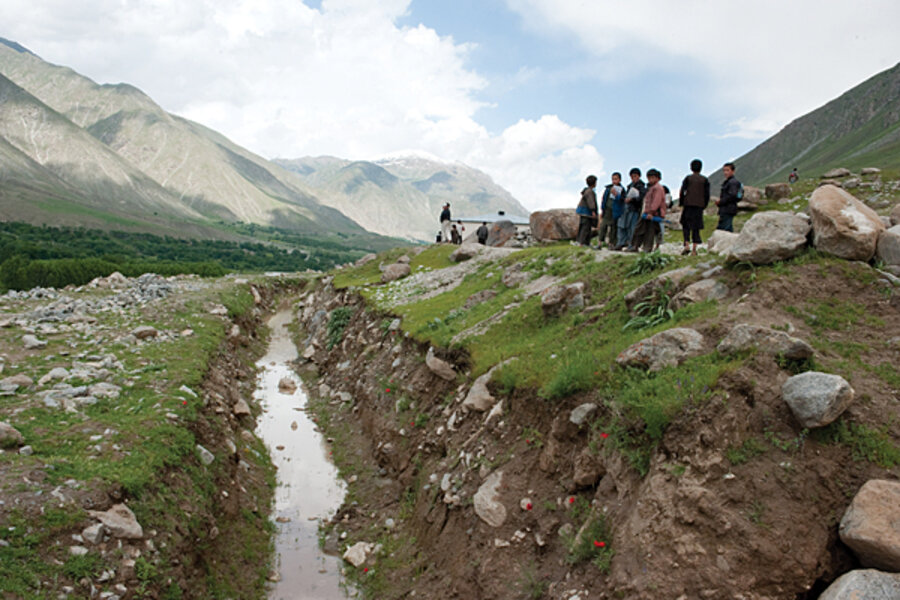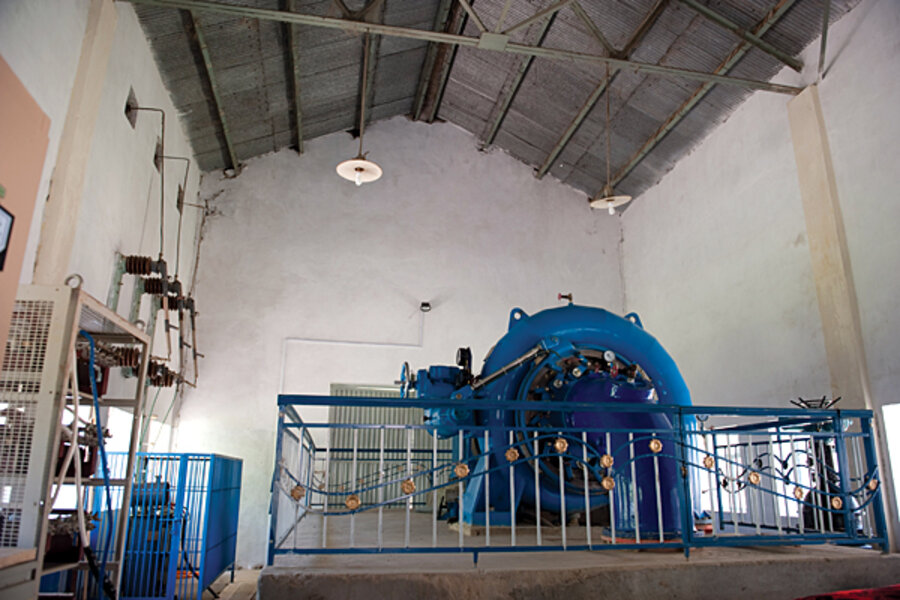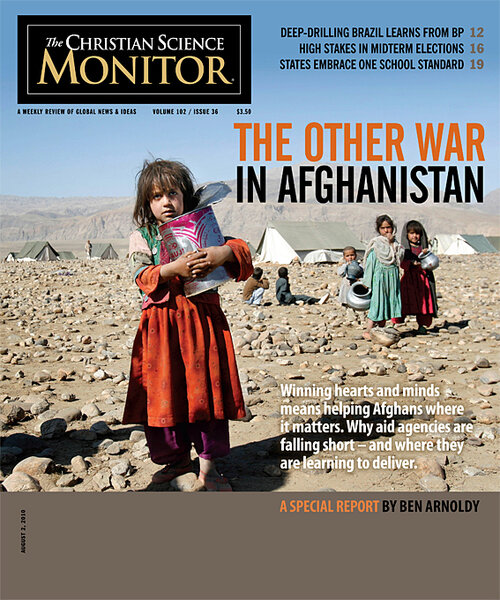Afghanistan war: How USAID loses hearts and minds
Loading...
| Baharak, Afghanistan
A muddy trench, crumbling at its sides, snakes from a swift stream five miles down to an aging hydropower plant in northeastern Afghanistan. Walking in sandals along the dirt banks, engineer Qand Agha Noori explains how Americans promised to build a proper canal to bring more electricity to his community.
But this excavated earth seems to be nothing more than a scar on the land – and on the impression Mr. Noori and his kith and kin have of Americans.
"Fifty percent they didn't do. They just dug this," Noori says of the empty ditch, "and tried to get the signature of the government and left."
He stops next to a boulder in the trench. He explains that shoddy construction – including incomplete concrete walls and drainage culverts – resulted in landslides blocking water flow to the turbine and, in turn, electricity from reaching any homes.
The $1 million canal was part of a $60 million development contract that the US Agency for International Development (USAID) had with PADCO, an American company. PADCO's 2009 completion report claims to have tripled power in Baharak and nearby Faizabad.
But Afghan officials say neither community saw any extra electricity. And a USAID staffer who handed over the report to the Monitor advised, "Take this with a grain of salt. It's designed to make USAID look good."
On paper, the multipronged project revitalized a backward Afghan province, weaning it off poppy cultivation and winning Afghan hearts and minds.
However, a Monitor investigation reveals that even in spite of a few modest gains, the Afghans here were left angered over project failures, secrecy, and wasted funds.
"Now the people are hating American companies like PADCO because many times they brought millions of dollars, but didn't do anything," says Syed Abdul Basir Husseini, the electricity chief for Badakhshan Province. "All Badakhshanis know that it was $60 million [that America] spent," he says, adding that they see little evidence of it.
The story of what went wrong exposes serious weaknesses in the third pillar of America's "clear, hold, build" Afghan strategy. Among them: big-spending hastiness, unrealistic deadlines, high development staff turnover, planning divorced from ground realities, and ever-present security risks in this war-torn nation.
"In Vietnam, they were measuring success of operations in the numbers that are killed. In Afghanistan, it is how many schools you are building and how much money you spent. This is better, but as wrong," says Lorenzo Delesgues, director of Integrity Watch Afghanistan, in Kabul. "What you need to measure is what is the impact of what you've done."
• • •
In 2005, the remote northeastern province of Badakhshan worried United States officials. Considered one of the safer regions of Afghanistan, it had become a major cultivator of poppy and a magnet for drug traffickers.
So USAID called for bids to spend $60 million on development there. The winner, PADCO (now called AECOM), had no experience in Afghanistan, but offered an ambitious crop substitution and economic development plan to build roads, irrigation canals, hydroelectric plants, and better agriculture. The project – Alternative Development Program/North (ADP/N) – ended in early 2009 with work hastily finished or left incomplete.
"They left on their schedule," says Abdul Wajid Wajid, the Afghan provincial planning minister at the time of the project.
For example, the cement walls on the Baharak power canal stop abruptly less than a mile from the start; at that point, landslide damage begins.
Work on the canal was delayed a year when one of the villages – angered by broken promises from a previous aid group – threatened to halt canal construction through its land. Then, toward the end of the project, some of the money needed to finish the work was diverted elsewhere, says Johannes Oosterkamp, an engineer who worked in Baharak for PADCO. That PADCO claims to have tripled power production is an "imprecision," he writes in an e-mail.
Indeed, the final evaluation report done by yet another USAID contractor concludes, "[U]nless the work on this [Baharak] canal is redone, its cost of over $1 million will have no benefit whatever." The report also notes that $650,000 was wasted on hydropower feasibility studies that disappeared.
The PADCO project brought "no added electricity," says Mr. Husseini, the electricity minister. He describes similar failures to deliver in Faizabad. PADCO said it was fixing two defunct hydroturbines – it didn't. PADCO spent $20,000 to fix a third, but it broke within days.
Mr. Oosterkamp never learned where unused portions of the canal funding went before he was fired, he says, for asking such questions. But he figures it may have gone toward another boondoggle – the paving of a 14-kilometer road between Faizabad and the village of Argo – done at the end of the project when money needed to be "burned" quickly.
A PADCO subcontractor upgraded the dirt road for $2.5 million. But the layer of asphalt measured only about an inch. Within three months the asphalt fell apart, says Abdul Jabar Mosadiq, a former district governor of Argo. Now the road is worse than before – pockmarked with gigantic potholes. But the village can no longer regrade it, thanks to the remaining patches of asphalt. Consequently, prices at the Argo bazaar rose 25 percent because delivery trucks now must come with smaller loads.
Business is good, however, for a tire repairman in Argo who says he fixes 10 tires a day, up from two before the paving.
"People know this was money of the American nation," says Mr. Mosadiq. "Mostly people are feeling that the same corruption that is in the government of Afghanistan is in the US and its companies and projects."
Mosadiq and provincial officials all say they felt powerless to protest cheap construction because PADCO refused to share budget figures for its work. The lack of transparency led locals to whisper that the former governor was getting a take, as well as his deputy, who rented his home to PADCO as an office.
The secrecy was to avoid corruption by local officials – "to prevent people putting their hand in the till when they could," says James Graham, former Afghanistan director of PADCO.
Some expenditures did become public when subcontracted work went through open bidding. "[A] lot of the complaints came from the fact that the local politicians couldn't control the actual process of letting the contracts," says Mr. Graham.
• • •
In the West's battle for hearts and minds, Baharak farmer Juna Khan, by all rights, should have been won over by what success USAID's program did achieve.
Bumper crops of vegetables and grain were reported throughout the region. And Mr. Khan says his farm income rose sharply because of PADCO's improved potato seeds and agricultural training. With the extra money, he opened a shop – exactly the effect the program hoped for.
But, ironically, Khan and many others in the region are left deeply distrustful of PADCO, and, by extension, the US.
Partly that's because of the secrecy in bidding and the wasteful spending. But a quirk of nature also seemed to increase it: Farmers in the region are convinced the new potato seeds brought the Colorado potato beetle, a voracious pest. It eats leaves, causing "lots of disadvantage" to the crop, says Khan.
There is plenty of evidence to show that the beetles already existed nearby and were not introduced here by PADCO, says Andrei Alyokhin, a potato beetle expert at the University of Maine, Orono, and unconnected to the project.
But the farmer, Khan, also believes PADCO compounded the beetle problem. To reduce use of insecticide, PADCO paid farmers to catch beetles (at $5 per bottle of 1,000 beetles). So farmers began breeding them in their homes, Khan says.
The beetle has taken away some of the gains in yield and much goodwill toward America.
• • •
PADCO declined to comment on the project. However, the Monitor visited portions of it and interviewed six former PADCO employees and numerous Afghan officials and residents of Badakhshan.
USAID refused interviews with staff in Badakhshan. Only after two months of requests did the agency grant two interviews: One with Jim Bever, head of Afghanistan-Pakistan policy for USAID, who could only go on the findings of the USAID evaluation and talk broadly about agency reforms; the other with a USAID staffer who'd worked as a PADCO contractor – but wasn't allowed to be quoted.
Mr. Bever's bottom line: "We and our Afghan partners probably overreached in terms of what we had hoped would be the results of the program in the time frame allotted. I think we need to learn the lessons from this effort."
But Bever resisted seeing some project failures as the responsibility of USAID. For instance, responsibility for maintaining the crumbling road to Argo falls to the Afghan government, he says. The same goes for some other elements of the project that proved unsustainable, including a veterinary lab in Faizabad that diagnosed samples sent by refrigerated car from sick animals. The lab is closed because the provincial government can't pay staff.
Local Afghan officials explain that they are, in fact, broke. USAID counters that the American government gives large sums to the Afghan government to spend as it sees fit on government services.
In one silver lining, PADCO also built 30 vet clinics, all of which operate today thanks to salary support from an aid group. An Afghan veterinary official lauded the construction of the clinics, which make it easier to get treatment for livestock.
USAID created an atmosphere of frantic urgency about the "burn rate" – a measure of how quickly money is spent. Emphasis gets put on spending fast to make room for the next batch from Congress.
Mistakes such as the Baharak canal and the Argo road – made under the heat of deadline toward the end of the four-year project – can be traced to unexpected delays at the beginning of the project.
Things started badly when the schedule, pushed by USAID, failed to factor in the long winter, says Jon Keeton, PADCO's first operations chief in Badakhshan. "They basically shouted at us: 'We must have projects on the ground, dug out, and started before the first snows.' This was in April. The first snows can start in Badakhshan by October. Congress had pushed $750 million that had to be spent."
But the project didn't launch in the first year because USAID in Kabul rejected PADCO's work plan, then three more – including one drafted by a consultant that USAID recommended. (Contract payments can flow only if a full project work plan is approved; absence of a work plan means that each tiny job requires written proposals and approval from USAID in Kabul.)
Mr. Keeton, who was followed by at least three PADCO project directors during the four-year program, describes one exasperating day in which his office worked to design individual projects, and USAID offices in Kabul would counter with different ones. Example: USAID heard of a promising program in eastern Afghanistan to produce vegetable oils and directed Keeton to adopt it. He balked, noting the different climate in Badakhshan. "Later that day," he says, "they changed [marching orders] to something else" in lieu of the oils.
Five months into Keeton's contract, PADCO fired him, saying USAID wanted him removed. His successor left after a few months, and the job fell to Graham, who faced similar frustrations with USAID during his 21-month tenure. "They sat in their compound in Kabul 24 hours a day and they got creative. You know, they had to keep from going nuts," he says. "We would get calls from creative people who had ideas and we were told to implement their ideas, and these folks didn't have a clue."
Finally, a year into the project, the fifth work plan was accepted – but Graham believes it happened because everyone waited for the USAID officer who'd denied past plans to go on vacation.
"It's almost unique in my experience as an AID officer that we would go through that many iterations to try to get closure on a work plan," Bever says, unable to confirm that four were rejected.
• • •
By May 2007, USAID determined that the project was not meeting midterm goals: Only 56 kilometers of roads were built toward a midterm target of 367 kilometers; and only 543 kilometers of irrigation canals had been built, with 945 kilometers targeted. Even by the end of the project, PADCO never achieved those midterm goals, having completed just 278 kilometers of roads and 576 kilometers of canals. The final targets appear to have been scaled down so that PADCO could claim to have "100 percent complete" on every line item – including the Baharak power canal.
USAID officials repeatedly stress the remoteness of Badakhshan as key to the project's slow start and subsequent problems: In 2005, it took a 24-hour drive from the nearest city of Kunduz to get to Badakhshan; there were no local contractors and there wasn't a single bulldozer in the province. PADCO had to spend a lot of time, therefore, training locals on construction.
Still, Keeton was dismayed by the degree of reliance on outsiders in the beginning. Cars and drivers were brought from Kabul, prompting protests from local drivers.
Some expatriate staffers, meanwhile, weren't prepared to rough it: One Indian engineer arrived with only city shoes, no work boots.
Keeton, a former Peace Corps volunteer, describes a staff meeting where he made it clear that premium salaries meant employees were being paid to go into the field: "[They] just looked at me ... 'What do you mean walk? What do you mean spend overnights in the villages?' "
On a trip to a remote site, Keeton recalls how the engineer in city shoes simply refused to walk across a fallen tree to cross a stream. Finally, a young Afghan picked him up and forded the water. "It was so humiliating."
Just getting staff in the first place was a challenge. "We were always down a third of the staff until the end," says Graham. "For periods of time I was [also] running the engineering office and I was saying to people, 'If we design a bridge while I am in charge ... don't walk over it!' "
Project workers from the outside had some reason to fear. In 2006, three Afghan workers for PADCO were killed and two American workers injured when their car was hit by a roadside bomb in Badakhshan. On the other hand, it has always been among the safest provinces.
By the end of the project, PADCO staffers traveled with armed escorts. A former Afghan staffer says the coterie of gunmen prompted one farmer to joke that maybe they came along to shoot the potato beetles.
Security directives keep USAID staff cloistered in their Kabul compound. On this project, that meant only one expatriate staffer for USAID was on the ground in Badakhshan – sometimes none. Turnover was high during the PADCO project, with at least six different people holding the job. When the project concluded, an Afghan employee was the only USAID representative on the ground. He – not an American – would be the one to check the work on the Baharak canal and send the "all done" back to Kabul. That monitoring situation is not rare, says Bever.
"That's the reality of aid in these kind of conflict zones where American government officers have difficulty getting out or don't have enough of them to get out," he says. During the final months of the project, USAID in Afghanistan was extremely short-staffed, and Badakhshan is "the most far-flung part of the world."
However, this Monitor investigation only spent a week on the ground and a few thousand dollars to uncover the hydropower falsehoods in the completion report that apparently went unnoticed by USAID. Outside evaluators found many of the same problems, but some 17 months after PADCO packed up.
• • •
Over the four-year project, United Nations data show, poppy cultivation fell in Badakhshan by 99 percent.
In 2005, Badakhshan was a province that had to import wheat to feed its people; by 2008, it was an exporter to other parts of Afghanistan, says USAID. Markets in places like Baharak that once had half a dozen vegetable traders now have scores.
Graham even defends PADCO's work: "The project was bringing in ways that people could make money and not grow poppy."
The final evaluation report ordered by USAID found that the project created up to $40 million in economic benefits, falling short of the $60 million spent. But while the project "was not as effective as it should have been," the report argues, it was still "worthwhile" because it brought "better personal mobility, exposure to new ideas and ways of thinking, improved nutrition, sociopolitical gains, objective evidence of [US government] concern, enhanced economic potential, etc."
But in the end, the US lost this battle in the "other war" for hearts and minds in Afghanistan. No local official is willing to credit PADCO for the successes.
"If we think about this project of alternative livelihoods, this did nothing for the people," says Mosadiq, whose community in Argo promised to stop growing poppy in exchange for the faulty road. "Instead of creating facilities, this created problems for the people."
Related:








